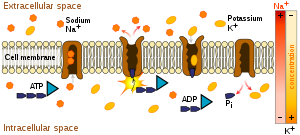Active transport

Active transport is the mediated process of moving particles across a biological membrane against a concentration gradient. If the process uses chemical energy, such as from adenosine triphosphate (ATP), it is termed primary active transport. Secondary active transport involves the use of an electrochemical gradient. Active transport uses energy, unlike passive transport, which does not use any energy.
Details
Specialised trans-membrane proteins recognize the substance and allows it access (or, in the case of secondary transport, expend energy on forcing it) to cross the membrane when it otherwise would not, either because it is one to which the lipid bilayer of the membrane is impermeable or because it is moved against the concentration gradient. The last case, known as primary active transport, and the proteins involved in it as pumps, uses the chemical energy of, usually, ATP. The other cases, which usually derive their energy through exploitation of an electrochemical gradient, are known as secondary active transport and involve pore-forming proteins that form channels through the cell membrane.
Sometimes one substance is transported in one direction at the same time as another substance is being cotransported in the other direction. This is called antiport. Symport is the name if two substrates are being transported in the same direction across the membrane. Antiport and symport are associated with secondary active transport, meaning that one of the two substances are transported against their concentration gradient utilizing the energy derived from the transport of the second substance (mostly Na+, K+ or H+) down its concentration gradient.
When particles are being moved from areas of low concentration to areas of high concentration (i.e., against the concentration gradient) then specific carrier proteins in the membrane are required to move these particles. The carrier proteins bind to specific molecules (e.g., glucose) and transport them into the cell where they are released. Because energy is required for this process, it is known as active transport. Examples of active transport include when sodium is transported out of the cell and potassium into the cell by the sodium-potassium pump. Active transport often takes place in the internal lining of the small intestine.
Plants need to absorb mineral salts from the soil, but these salts are in very dilute solution. Active transport enables these cells to take up salts from this dilute solution against the concentration gradient.
ABC pumps
ABC class pumps transport small molecules across membranes.
Examples
- Water, ethanol, and chloroform are simple molecules that do not require active transport to cross a membrane.
- Metal ions, such as Na+, K+, Mg2+, or Ca2+, require ion pumps or ion channels to cross membranes and distribute through the body
- The pump for sodium and potassium is called sodium-potassium pump or Na +/K+-ATPase
- In the epithelial cells of the stomach, gastric acid is produced by hydrogen potassium ATPase, a proton pump[citation needed]
Endocytosis
Endocytosis is the process by which cells ingest materials. The cellular membrane folds around the desired materials outside the cell. The ingested particle is trapped within a pouch, vacuole or inside the cytoplasm. Often enzymes from lysosomes are then used to digest the molecules absorbed by this process.
Endocyctosis can be split up into two main types: pinocytosis and phagocytosis.
In pinocytosis, cells engulf liquid particles (in humans this process occurs in the small intestine, cells there engulf fat droplets)
In phagocytosis, cells engulf solid particles.
Exocytosis
Exocytosis is the process by which cells excrete waste and other large molecules from the protoplasm
